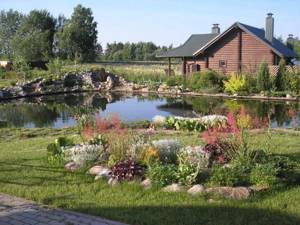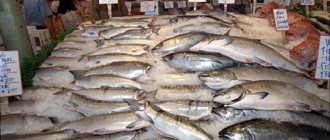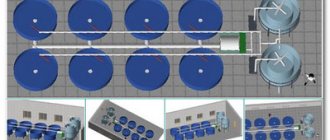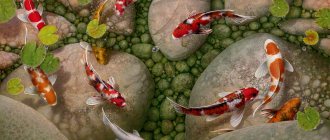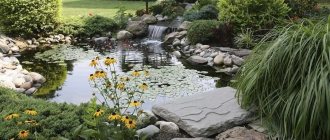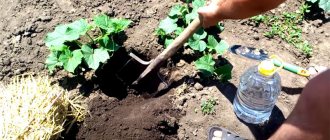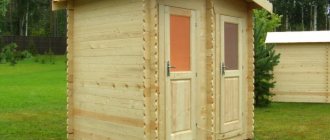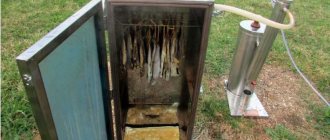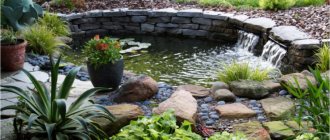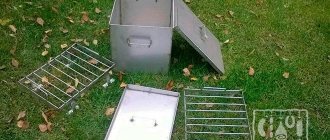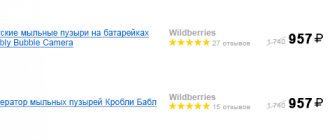Step-by-step opening plan, where to start
To open your own carp fishery, you need to pay special attention to the place where the fish are raised. A small reservoir or pond is suitable for carp. It is advisable to first monitor and analyze the activities of competitors and establish connections with sales points. You cannot do without a clearly verified business project, taking into account preliminary costs and expected profits.
The profitability of the business in the first stages will depend on this. Having improved the reservoir and the surrounding area, you can begin purchasing the necessary equipment, fry and food for them.
Stages of fish breeding
In order to choose the right strategy for building a fish farm in advance, you need to know that in a commercial fishery there are several stages of fish breeding:
– spawning stage
– juvenile stage
– wintering stage
– adolescence stage
– feeding stage
Thus, on fish farms they achieve a clear delineation of periods of fish development. In spawning reservoirs, the larvae are hatched from the eggs, and then they are successively transplanted into the fry, hatchery and feeding ponds. From spring to late autumn, the grown and strong young generation lives in feeding ponds.
With the arrival of winter, young fish are moved to a special wintering pond . In general, by the end of autumn the fish is able to reach the required marketable weight and can be successfully sold.
The main feature of an excellent fish pond is the presence of a variety of biological processes and their complete control. That is, in artificially created reservoirs they not only raise fish or other fresh water inhabitants, but also independently set the necessary course for these biological processes.
The main indicator of good control in relation to a fish farm is clean, oxygen-rich water in the reservoir. To maintain a favorable microclimate, you need to take care in advance that there is no methane or hydrogen sulfide in the water.
To do this, it is best to initially ask the relevant services for geodetic data of the territory. If possible, it is better to hire specialists yourself and conduct a geodetic survey of the area.
In addition to all this, for the most favorable development of fish, many trace elements and minerals must be present in the water, such as phosphorus, potassium, calcium, nitrogen, etc. This is achieved with the help of seedlings of special breeds of algae, as well as by artificially enriching the reservoir with useful substances. This is what specialized companies do today.
In general, in order for the conditions of a fish farm to meet all modern standards, you need to understand one simple mechanism: everything in the pond must be interconnected in a ring pattern.
Everyone knows what the process of synthesis in nature is, right? For those who have forgotten the school curriculum, let us remind you that synthesis is the exchange between living organisms of energy that initially enters the earth through the sun's rays.
This is also what we should strive for when creating and operating a fish farm: all living organisms in a reservoir must be interconnected by natural processes.
How much can you earn
Before we get to the profit, let's look at the costs. If you grow carp in a natural reservoir, then the main expenses are associated with the purchase of food, about 20 rubles per 1 kg. For a small fish farm, this will cost up to 5,000 rubles per month. Purchase of fry: 100 pieces = 400 rubles. This should include the costs of equipment, transportation costs, insurance premiums, etc.
To reach marketable weight, carp need 2-3 years. Thus, there is no need to expect quick profits. You can sell fish at a price of 80-100 rubles per kg. An additional income channel is provided by paid fishing, along with the rental of fishing rods/boats, paid parking and other equipment. The profitability of the business, taking into account a well-established sales market, is at the level of 10%. The profit received can be used not only to expand the business, but also to acquire profitable assets. There are many opportunities for this, for example, investing in apartment buildings. This is a time-tested method that works.
Call us
Here's how to stock a pond with fish:
- The fish must be disinfected. To do this, prepare a saline solution from pond water at the rate of 1 tablespoon of salt per 1 liter. water, then the fish is placed in a container with this solution for 3 minutes, after which it can be released into the pond. Before launching, it is worth carefully examining the individuals for unknown wounds, spots, growths, and do not release any suspicious ones into the pond.
- You can launch fish of any age, fry, grown-up individuals over a year old, as well as adult fish.
- For good results, follow the rules for adding cold-resistant and heat-loving fish. Cold-resistant fish (pike, catfish, trout) feel great at a temperature of 0-2 C. For heat-loving fish (carp, perch, tench), you need to wait until the water warms up to 5-10 C. If the temperature difference between the container in which the fish was transported and the pond water is too great, the fish may experience temperature shock and die.
- It is possible to populate a pond with fish during the entire warm period - from the end of the spring flood to late autumn.
Which equipment to choose
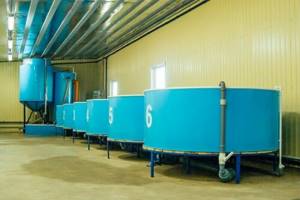
To effectively run a carp farming business, you will need to purchase fishing rods, boats, camping tents and other equipment for paid fishing.
Professional business plans on the topic:
- Fisheries business plan (21 sheets) - DOWNLOAD ⬇
- Business plan for paid fishing (20 sheets) - DOWNLOAD ⬇
- Business plan for a fishing store (13 sheets) - DOWNLOAD ⬇
Business idea
Before making a decision, you need to be informed in all the intricacies of breeding, because every business has its own pitfalls. Until today, Russia had many large fish farming enterprises, but they soon went bankrupt and could not withstand competition with foreign industrial companies. The remaining Russian fishing companies cannot adequately supply the entire country, so the Russian Federation has to make large purchases from outside .
Even today, fish farming does not lose its relevance. Growing in artificial ponds is divided into several categories:
- Breeding in mini-reservoirs.
- Cage cultivation.
- Breeding in the pool.
- Growing in a pond.
What documents are needed to open
A novice businessman will need to register an individual entrepreneur or LLC, which will require a passport, a copy of the ID code and a receipt for payment of the state duty.

It is worth paying attention to the grants existing in Russia from the Ministry of Agriculture. When registered, there is a chance to receive significant start-up capital or half of the funds invested in the business.
How to breed fish in a pond? Growing technology
Fish in a pond usually takes 1.5 to 2 years to grow. During this time, she manages to gain sufficient weight. Growth and productivity are influenced by the quality of water, the amount of food and the climate zone in which the farm is located.
Fish can be grown either intensively or extensively.
- Extensive method - in this method the fish are not fed, they consume natural food. Fish grows with minimal investment.
- Intensive method - in this case, the fish are fed and, in addition, a rich food supply is created through the reclamation of the reservoir.
Several technologies for intensive cultivation of fish in a pond are known.
Traditional technology. It includes a 2 or 3 year growing cycle. This is how carp and other herbivores are bred. The main disadvantage of this method is its multi-stage nature. Each technological operation is carried out in a special pond. The completion of each stage is the release of water. In the process of implementing this technology, fish are transplanted several times: from nursery ponds to wintering ponds, from wintering ponds to feeding ponds. All these transplants are fraught with numerous losses. Another disadvantage of this method is the labor intensity of the processes. This method can only be effective if a number of requirements are met, namely: the water must be constantly running, it must be technically aerated, and the pond must be limed.
Continuous technology. It has recently enjoyed greater popularity than the one discussed in paragraph 1. This method involves raising young fish to a weight of 1 - 1.5 kg and further keeping the fish without transplanting for several years. In this case, you will need two ponds - a fry pond and a feeding pond.
Nutritional Features
In order for nutrition to be effective, it is necessary to know such factors as: the biological characteristics of a particular fish species, nutritional needs and the possibilities of their growth. The efficiency of nutrition directly depends on the environmental conditions in which the fish is located. Growth can be accelerated by feeding foods rich in proteins.
The energy needs of fish are relatively small. To gain 1 kg of body weight, food must contain at least 4500 kcal of energy. Fry have a great need for amino acids: arginine, leucine, lysine, valine, tryptophan, methionine, etc. If these amino acids are not enough in food, the fish may lose appetite, as a result of which growth rates will decrease. In addition, amino acid deficiency can lead to diseases.
Food should include fats of plant and animal origin. Their insufficient quantity will lead to the fact that the fish will stop growing, a disorder of physiological functions and tissue watering will occur, and irreparable changes in the liver may occur.
Food must contain fiber. For different types of fish its content is different. For salmon and trout, the smallest amount is required - 20%. In food for carp and catfish it should be at least 40%.
Fish food must necessarily contain biologically active substances. These can be premixes and enzyme preparations. Feeds of plant origin (cereals) are a source of carbohydrates and B vitamins. Bran should be included in fish feed mixtures.
A necessary component of a complete feed is animal feed. This is meat and bone and krill meal. For young animals, you need to use dairy products: skim milk powder and low-fat milk powder.
Possible diseases
The big risk in growing fish in a pond is its diseases, which can turn into epidemics. The condition of the fish must be monitored every 10 days. The most common diseases inherent in freshwater fish:
- aeromonosis (rubella). Symptoms: inflammation of the skin, dropsy, small areas of hemorrhage, bulging eyes;
- diseases of the gill apparatus (gill rot). The appearance of this disease is promoted by high water temperature and high content of organic substances in it. Symptoms: pale gill tissue, uneven death of its edges. The large fish stops eating and becomes inactive;
- discocotylosis is a disease of salmon and grayling fish. Young animals suffer the most from this disease. Symptoms: injuries to gill tissue;
- Ichthyophthyriasis is a typical disease for many species of fish. A characteristic sign is the presence of white bumps on the body;
- Fish dactylogyrosis - this disease is characteristic of pond fish. The disease becomes more active in the summer. It is mainly the fry that suffers. Symptoms: small individuals are not active enough, swim near the surface. The fish is very emaciated, the eyes are sunken, and anemia of the gills is visible.
Business for gardeners: growing strawberries at home for sale.
Crisis option: we launch our own production of cheese products.
Real chance to make money on bees:
Do I need permission to open?
To stock a reservoir with fish, it is mandatory to obtain a special veterinary certificate, which is issued by the epidemiological committee. Moreover, renting a territory from the state will require several additional papers related to maintaining cleanliness and environmental safety. Are you thinking about making quick money or dreaming of owning your own home? Does your mortgage seem unaffordable? Learn about mortgage takers' mistakes and how to do it right. Don’t lose your nerves and money by giving the bank more than 10 years.
( 4 ratings, average: 5.00 out of 5)
Loading…
Similar business ideas:
- TOP 30 business ideas with minimal investment
- Printing house - 3 business advantages
- How much does a psychologist earn in %am_current_year%
- How to invest in REITs: 3 criteria for choosing a fund...
Secrets of breeding fish in artificial reservoirs

When there are no problems with water on a site, the question arises of how to diversify and transform this very site?
Artificial ponds can not only be a spectacular part of the design, but also bring good benefits. Breeding fish in artificial reservoirs is an exciting activity that allows you to diversify your leisure time and grow environmentally friendly fish. When deciding to create a reservoir for fish breeding in order to make your dream of fishing at your own dacha come true, you need to organize everything correctly. This is what we will talk about today.
What should be the optimal size of a reservoir?
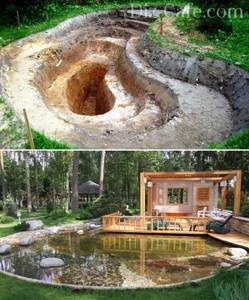
An ideal option for a good rest and your favorite pastime, fishing, is to locate the site near an existing body of water. In the absence of the opportunity to use the benefits of nature, owners of personal plots can always create a pond for fish breeding with their own hands.
The dimensions of the pit may vary depending on the preferences and capabilities of the owner of the site. A small pond can accommodate up to two dozen crucian carp and several medium-sized carp. On average, 10 to 20 fish are taken per 1 cubic meter of water.
For breeding carp and crucian carp, a home pond measuring 4x6 meters, with a reservoir depth of 0.8 to 1.5 meters, is optimal.
The main advantage of such a pond size is that the water warms up quite quickly in the summer to a temperature of 24-26 degrees, which is the most favorable for the life of these species. A decrease in the temperature in a reservoir to 12 degrees can lead to a decrease in feeding intensity and growth activity in fish. An increase in temperature above 30 degrees also leads to a decrease in the activity of vital processes of carp and crucian carp.
About fish
Carp is a fish that lives well in fairly small areas. As practice shows, carp in small reservoirs increases their mass faster than in large ponds. This is due to the fact that in a small area the fish spends less energy searching for food. A small pond is also convenient for the owner, since a small body of water is easier to care for.
We are building a pond
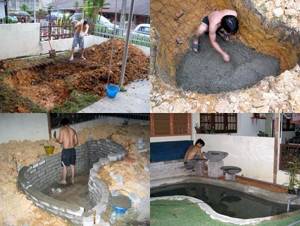
Having decided on the size of the future pond and having dug a pit, the soil surface should be leveled and compacted. It is advisable to cement the bottom of the future reservoir.
An alternative budget option is to use thick polyethylene film to cover the bottom.
With careful use of the film, a sufficiently strong base can last for more than one season. Placing pre-glued together inner tubes from trucks at the bottom of the pit is also a fairly common option that does not require large financial costs.
If you want to breed crayfish in addition to fish in the pond, you can place broken pots, pipes and stones of various sizes at the bottom of the reservoir. Such “hides” will allow crayfish to hide from fish during the molting period.
The shore of the reservoir can be planted with moisture-loving plants such as reeds and willow.
We fill the pond with artesian water from a well and it’s done! Now fishing is possible at any time convenient for you.
When to start fish?
There is no need to rush into introducing fish into practically “sterile” water in the first days. The water should warm up well in the sun, settle and acquire microorganisms. In other words, the water must become “living”. A couple of buckets of “living” water transferred from an established pond, as well as a bunch of wilted grass lowered to the bottom of a new reservoir, will help speed up the process of enriching water with microflora.
An equally important condition for releasing fish into a reservoir is the optimal temperature regime. It is very important that the temperature of the container with fish and the pond is absolutely the same. The process of equalizing the water temperature of a container with fish with the temperature inside the reservoir will reduce the risk of fish developing temperature shock, which can lead to the death of even adult fish during the first day.
What to feed the fish?
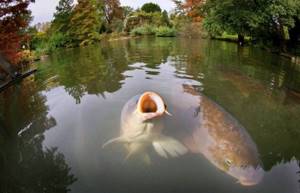
Breeding fish in artificial reservoirs also involves artificial feeding, which can significantly increase weight gain. Since carps are omnivores, it is quite possible to use feed intended for poultry and pigs to feed the fish.
Loose, loose feed should be added in the form of porridge or thick dough, which is formed by mixing the feed with water in a bucket. A substitute for mixed feed can be grains of legumes and cereals, which are given in a steamed, swollen form. The ratio of the volume of grain feed to the weight of fish should not exceed 3-5%.
When organizing feeding of fish, it is advisable to adhere to a certain schedule. The fish are fed at the same time 1-2 times a day in a specially designated place. When setting up a feeding area, you can prepare a tray table that can be easily lowered and removed from the water. The use of a “feeder” will allow you to control the presence of uneaten food residues, the souring of which can spoil the water. To develop a conditioned reflex in individuals, calling the fish to feed, you can use a bell.
Selecting a location
When creating a fish pond, its correct location is important. The lowest, sunny place on your site is well suited for this purpose.
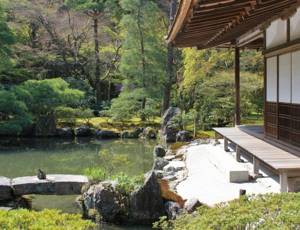
There should be no trees or shrubs nearby - their roots can damage the bowl of the reservoir. It is also recommended to locate the pond away from buildings to prevent their shrinkage.
